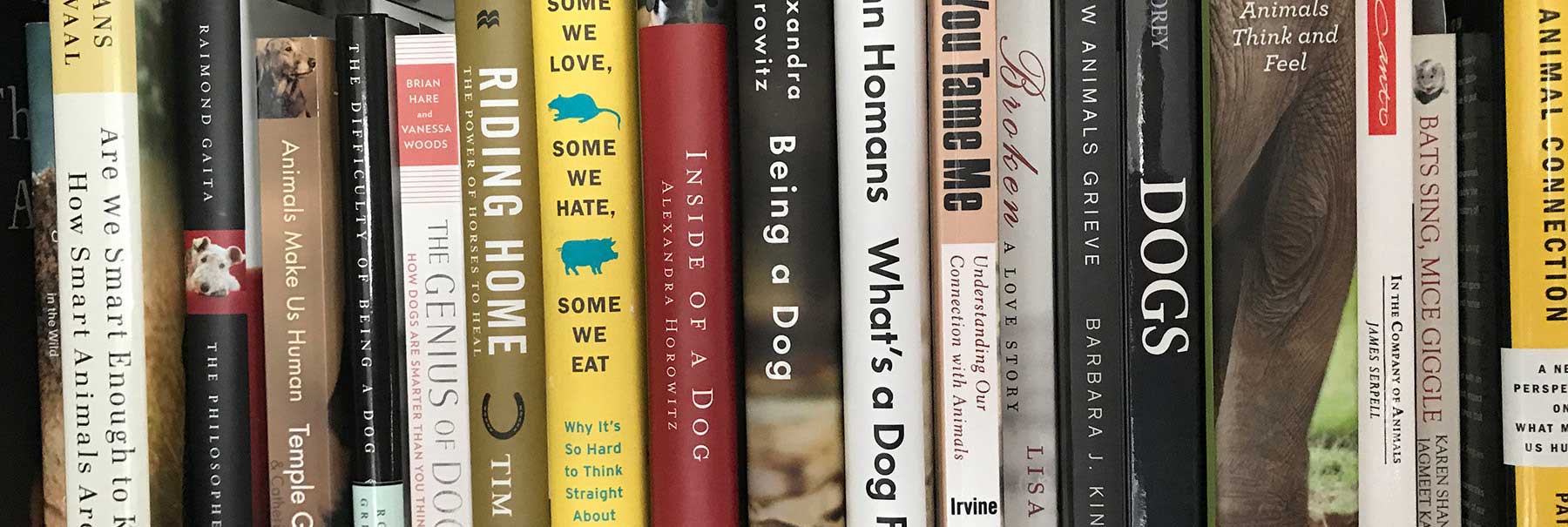
About This Site
In 2009, as I was preparing to teach an upper-level college research course, I decided to pursue some research entirely outside my field so that I would be a novice learner again, like my students. My plan was to track my research processes and describe these steps to help my students. Little did I know I was setting out on a bigger journey.
I’d recently had a vivid dream about my cat—one of a long series—so I used dreams about animals as my research topic. Why do humans dream about animals so often? And I posed a related question: Why do animals play crucial roles in so many fairytales and folk tales the world over? I found books on these subjects, but quickly got pulled in new directions as I learned more—just like when I was a student—and realized that what really interested me was the human-animal bond, now and in the past.
In the library catalog under “Pets—History” I found James Serpell’s In the Company of Animals: A Study of Human-Animal Relationships, first published in 1986. When Serpell, a zoologist, began his research on pet-keeping in the 1970s, he discovered that the subject of keeping pets was “virtually terra incognita” for scholarly study. Only anthropologists approached human-animal interactions scientifically. There was resistance to studying something so mundane, so sentimental. As Serpell worked, he met others—zoologists, veterinarians, psychologists, doctors, and social workers—who were also focusing on the nature of our relationships with companion animals. During this same period, dogs, which had been long overlooked by animal behaviorists, also became a subject of scientific study.
“Pets—History” led me to the subject heading “Human—Animal Relationships,” where I found a brand new book (in 2009), Meg Daley Olmert’s Made for Each Other: The Biology of the Human Animal Bond. Olmert, a science writer, drew on recent studies in neuroscience, evolutionary biology, behavioral psychology, and archaeology and hypothesized that brain chemistry and neurological function may underlie the connection between humans and animals.
Between 1986 and 2009 people in many fields had begun to explore Serpell’s terra incognita.
I had stumbled into an expanding field, dedicated to the multidisciplinary study of human-animal relationships. I prepared my course, but also started reading. And kept reading. I was hooked.
Over the next few years, I developed a course called “Pets and People” as part of my college’s interdisciplinary core curriculum. Despite being required, the course attracted students. Part of its appeal (besides the obvious) was that it brought academic study—including potentially intimidating fields like ethology, cognitive psychology, and paleoanthropology—right into our kitchens and living rooms.
I loved teaching this course. We explored topics such as animal domestication, the cognitive and sensory capabilities of dogs and cats, animal emotions, and service animals. Students pursued their own research projects: cross-cultural attitudes toward dogs, factory farming practices, monogamy in animals, the use of service dogs to support children with Autism Spectrum Disorder, and the positive effects of establishing training programs for service dogs in prisons.
In 2016, Burlington College closed. It was really difficult to lose this job for many reasons—losing the paycheck, of course; losing students and colleagues; and losing the sense of shared purpose. I hadn’t anticipated that it would also be painful to “lose” specific courses. You can’t just pick up a course and offer it somewhere else, especially when it’s off-beat. “Pets and People” is the course I miss the most.
This website is a response to that loss. I wanted to keep going and do something with everything I was discovering about human-animal relationships. Pets, People, and Other Animals is that something. It’s meant to be engaging, informative, and entertaining for anyone interested in pets (and their people).
There are two sections, Articles and Animals Etc. The first includes short to medium-length articles about the animals in our lives and our relationships with them. I’m interested in all sorts of things, so I can’t predict where my curiosity will lead, but I keep following it on the theory that the more interested I am, the better the article will be. Within each article are links to relevant materials and references for people who are interested.
The second section, Animals Etc., is more informal. It includes poems, short book reviews, photographs, links, and other things I find along the way. Happy reading! And enjoy the cute photos. No one knows yet what the exact science is, but our brains light up when we see puppy dog eyes or little kittens.

